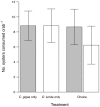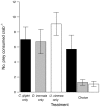Preference alters consumptive effects of predators: top-down effects of a native crab on a system of native and introduced prey
- PMID: 23236472
- PMCID: PMC3516545
- DOI: 10.1371/journal.pone.0051322
Preference alters consumptive effects of predators: top-down effects of a native crab on a system of native and introduced prey
Abstract
Top-down effects of predators in systems depend on the rate at which predators consume prey, and on predator preferences among available prey. In invaded communities, these parameters might be difficult to predict because ecological relationships are typically evolutionarily novel. We examined feeding rates and preferences of a crab native to the Pacific Northwest, Cancer productus, among four prey items: two invasive species of oyster drill (the marine whelks Urosalpinx cinerea and Ocenebra inornata) and two species of oyster (Crassostrea gigas and Ostrea lurida) that are also consumed by U. cinerea and O. inornata. This system is also characterized by intraguild predation because crabs are predators of drills and compete with them for prey (oysters). When only the oysters were offered, crabs did not express a preference and consumed approximately 9 juvenile oysters crab(-1) day(-1). We then tested whether crabs preferred adult drills of either U. cinerea or O. inornata, or juvenile oysters (C. gigas). While crabs consumed drills and oysters at approximately the same rate when only one type of prey was offered, they expressed a strong preference for juvenile oysters over drills when they were allowed to choose among the three prey items. This preference for oysters might negate the positive indirect effects that crabs have on oysters by crabs consuming drills (trophic cascade) because crabs have a large negative direct effect on oysters when crabs, oysters, and drills co-occur.
Conflict of interest statement
Figures



Similar articles
-
Invasive species cause large-scale loss of native California oyster habitat by disrupting trophic cascades.Oecologia. 2009 Jun;160(3):563-75. doi: 10.1007/s00442-009-1322-0. Epub 2009 Apr 8. Oecologia. 2009. PMID: 19352719
-
Behavioral plasticity in an invaded system: non-native whelks recognize risk from native crabs.Oecologia. 2012 May;169(1):105-15. doi: 10.1007/s00442-011-2188-5. Epub 2011 Nov 15. Oecologia. 2012. PMID: 22083283
-
Inducible defenses in Olympia oysters in response to an invasive predator.Oecologia. 2017 Mar;183(3):809-819. doi: 10.1007/s00442-017-3811-x. Epub 2017 Jan 13. Oecologia. 2017. PMID: 28084530
-
Habitat complexity influences cascading effects of multiple predators.Ecology. 2008 Dec;89(12):3413-22. doi: 10.1890/07-1057.1. Ecology. 2008. PMID: 19137947
-
Using functional responses and prey switching to quantify invasion success of the Pacific oyster, Crassostrea gigas.Mar Environ Res. 2019 Mar;145:66-72. doi: 10.1016/j.marenvres.2019.02.010. Epub 2019 Feb 21. Mar Environ Res. 2019. PMID: 30827778
Cited by
-
The role of kelp crabs as consumers in bull kelp forests-evidence from laboratory feeding trials and field enclosures.PeerJ. 2017 May 25;5:e3372. doi: 10.7717/peerj.3372. eCollection 2017. PeerJ. 2017. PMID: 28560113 Free PMC article.
-
eDNA confirms lower trophic interactions help to modulate population outbreaks of the notorious crown-of-thorns sea star.Proc Natl Acad Sci U S A. 2025 Mar 18;122(11):e2424560122. doi: 10.1073/pnas.2424560122. Epub 2025 Mar 10. Proc Natl Acad Sci U S A. 2025. PMID: 40063810 Free PMC article.
-
Destabilizing effects on a classic tri-trophic oyster-reef cascade.PLoS One. 2020 Dec 15;15(12):e0242965. doi: 10.1371/journal.pone.0242965. eCollection 2020. PLoS One. 2020. PMID: 33320866 Free PMC article.
References
-
- Paine RT (1974) Intertidal community structure - experimental studies on relationship between a dominant competitor and its principal predator. Oecologia 15: 93–120. - PubMed
-
- Hixon MA, Beets JP (1993) Predation, prey refuges, and the structure of coral-reef fish assemblages. Ecological Monographs 63: 77–101.
-
- Gherardi F, Acquistapace P (2007) Invasive crayfish in Europe: the impact of Procambarus clarkii on the littoral community of a Mediterranean lake. Freshwater Biology 52: 1249–1259.
-
- Fitzner RE, Eberhardt LE, Rickard WH, Gray RH (1994) Great Basin Canada goose nesting on the mid-Columbia River, Washington: An historical perspective and update, 1981–1990. Northwest Science 68: 37–42.
Publication types
MeSH terms
LinkOut - more resources
Full Text Sources

